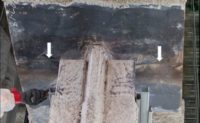U.S. Supertowers, Megaprojects Retake Center Stage
In other concrete milestones, the American Concrete Institute released its first overhaul in nearly 50 years of Building Code Requirements for Structural Concrete, ACI 318. The tome was reorganized for easier use and some new subjects were added. ACI also released its revised and expanded "Formwork for Concrete" manual, a 500-plus-page publication.
Last year, there was a big advance in green building research. The Lawrence Berkeley National Laboratory opened its $15.7-million Facility for Low-Energy Experiments in Buildings. At FLEXLAB, outside users can plug-and-play office space for full-scale performance tests on energy-efficient technologies and systems.
The first earthquake simulation tests on a wood-framed house—equipped with newly developed low-cost seismic base isolators—confirmed researchers' predictions that the two-story house would come through structurally unscathed. The goal is to commercialize the isolators and improve the performance of houses in quakes, without having a big impact on their price tags.
In September, at a nondescript shipping-container-like facility at the Bronx Zoo in New York City, benign-to-bird tests began on different types of bird-friendly glass, as part of an initiative led by the American Bird Conservancy. The test tunnel will help scientists develop an American Society for Testing and Materials standard for bird-friendly glass. That in turn will help glassmakers produce the material glass and designers specify it.
Efforts continue to make flood-prone areas and buildings more resilient. In June 2014, U.S. Secretary of Housing Secretary and Urban Development Shaun Donovan announced the award of $930 million to the winners of HUD's Rebuild by Design competition. In the fall, Boston Mayor Martin J. Walsh (D) kicked off an international design competition to attract ideas for saving vulnerable areas from the rising tides. In the U.K., construction was finished on a small but significant house—a 225-sq-meter cottage that floats during floods, thanks to a concrete tub-like basement foundation. The house, located on a flood-prone island 10 m from the edge of the River Thames in Marlow, Buckinghamshire, is the U.K.'s first amphibious house.
Net-zero annual energy use seems to be in the air everywhere. The first multi-tenant speculative office building in the U.S. aiming for certification by the International Living Future Institute's rigorous Living Building Challenge will soon complete its first year of operation while fully occupied. Bullitt Center is built to satisfy its own energy, water and waste needs in a revenue-producing environment. The building also serves as a living laboratory and educational center to elevate environmental awareness.
In another move forward for green building, the first phase of the total overhaul of the world's busiest border crossing, located in arid Southern California, is all but done. The project, which reduced vehicle-waiting times from two to four hours to 15 to 45 minutes, is on course to take care of its own energy, non-potable water and waste treatment needs. The $741-million San Ysidro Land Port of Entry makeover is considered a model for other land ports.
The project exemplifies another trend in design and construction: mainstream use of prefabrication, preassembly and modular components. Many traditional contractors are embracing the strategy to increase quality and safety, save time in the field and reduce costs.
The poster project for extreme modular construction—the planned 32-story B2 BKLYN at the renamed Pacific Park Brooklyn development in New York City—remains stalled at 10 stories due to a bitter dispute between the developer and its original construction manager. Aside from that black mark, several less ambitious, mostly modular residential projects opened. The National Institute of Building Sciences is so upbeat about the potential for permanent modular developments that it created the Off-Site Construction Council to advance all types of prefabrication and preassembly.





